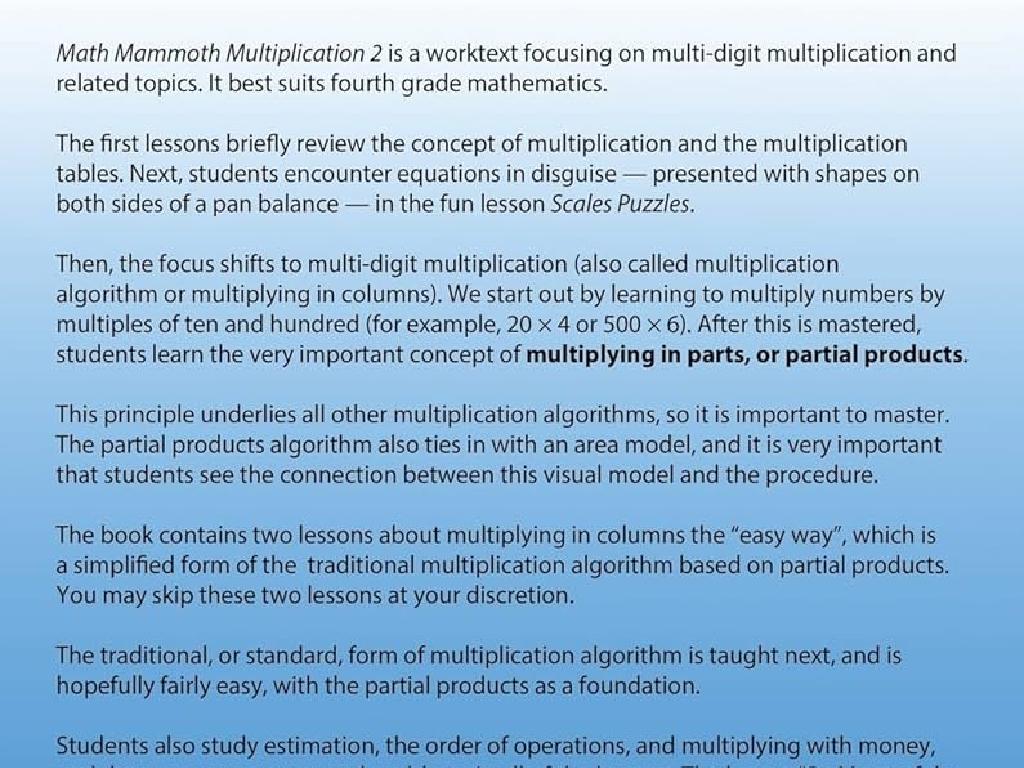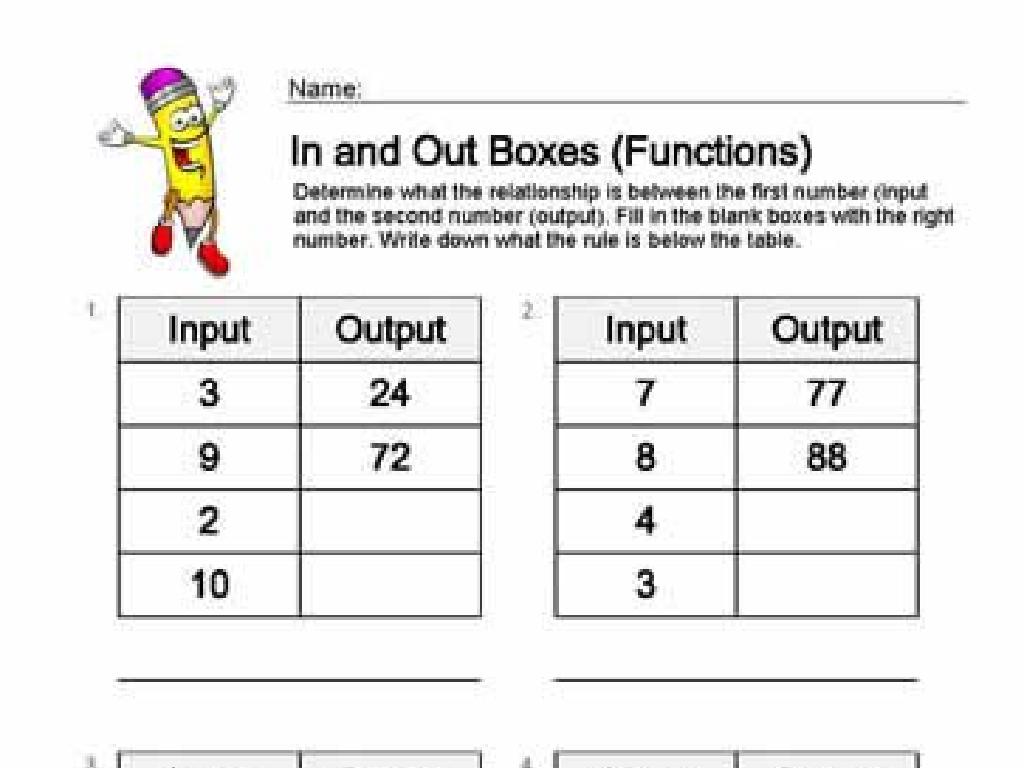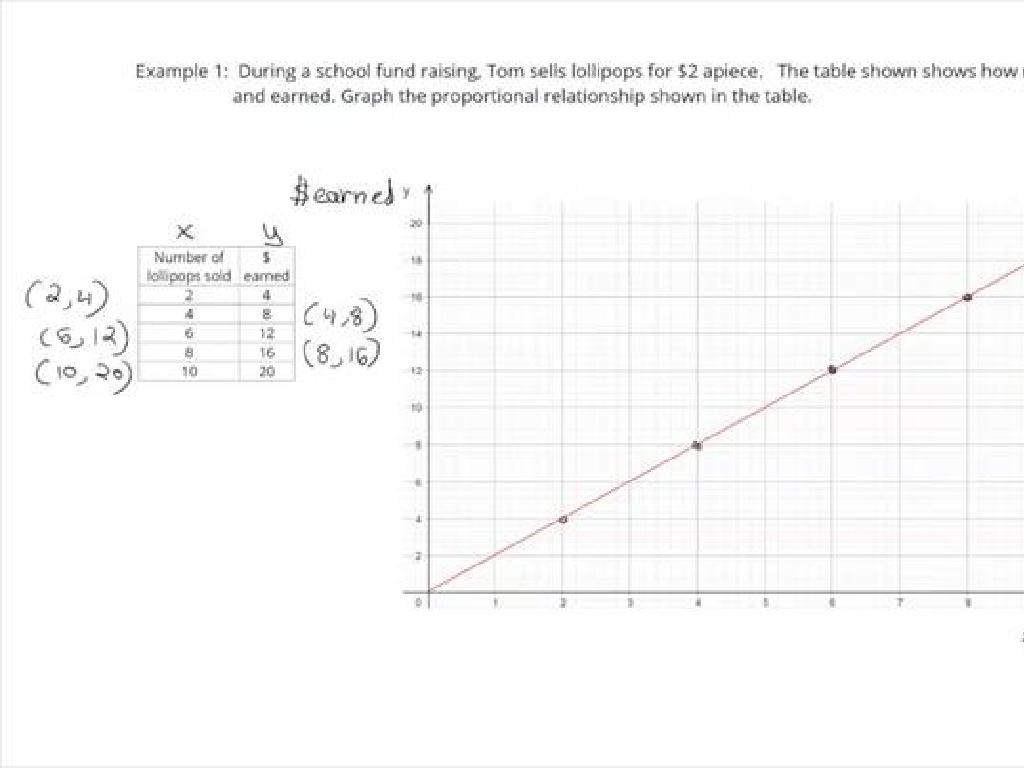Properties Of Multiplication
Subject: Math
Grade: Third grade
Topic: Multiplication Properties
Please LOG IN to download the presentation. Access is available to registered users only.
View More Content
Welcome to Multiplication Properties!
– Greetings, young mathematicians!
– What is multiplication?
– Multiplication is adding a number to itself repeatedly.
– Discovering multiplication properties
– Properties are rules that help us multiply.
– Exploring Commutative, Associative, and Distributive
– Commutative: Order doesn’t matter. Associative: Grouping doesn’t matter. Distributive: Break apart numbers to multiply.
|
Begin the class with a warm welcome to set a positive tone for learning. Introduce multiplication as a concept of adding the same number multiple times, which is a foundational skill in math. Explain that today’s lesson will focus on understanding the main properties of multiplication, which are rules that make multiplying easier and faster. These properties include the Commutative Property (changing the order of numbers doesn’t change the answer), the Associative Property (changing the grouping of numbers doesn’t change the answer), and the Distributive Property (breaking up numbers into parts can simplify multiplication). Use simple examples to illustrate each property, ensuring that students grasp the concepts before moving on to more complex problems.
Understanding Multiplication
– What does multiplication mean?
– Multiplication is adding the same number over and over.
– Multiplication as repeated addition
– For example, 3 x 4 is the same as 4 + 4 + 4.
– Multiplication in daily life
– We use it to calculate total items, like 3 packs of stickers with 4 in each pack.
|
Begin the lesson by recapping the concept of multiplication, ensuring that students understand it as a method of adding the same number multiple times. Use visual aids or physical objects to demonstrate multiplication as repeated addition, such as adding groups of the same quantity. Relate multiplication to everyday scenarios, like combining equal groups of items, to help students see its practical application. Encourage them to think of their own examples where they might use multiplication outside of school. This will help solidify their understanding and recognize the relevance of multiplication in their daily lives.
Commutative Property of Multiplication
– What is Commutative Property?
– It means you can multiply numbers in any order.
– Order doesn’t change the product
– Whether we do 3 x 4 or 4 x 3, the answer is the same: 12.
– Example: 3 x 4 equals 4 x 3
– This shows us that 3 groups of 4 is the same as 4 groups of 3.
|
The Commutative Property of Multiplication states that changing the order of the numbers we are multiplying does not change the product, or the answer. It’s like saying it doesn’t matter if we have 3 groups of 4 apples or 4 groups of 3 apples, the total number of apples will always be 12. Use simple examples with small numbers to illustrate this concept. Encourage students to try this with different numbers to see that it always works the same way. This property helps make multiplication faster and easier to understand.
Associative Property of Multiplication
– What is Associative Property?
– It means changing groups of numbers doesn’t change the answer.
– Grouping doesn’t change product
– Example: (2 x 3) x 4
– First, do 2 x 3, then multiply by 4.
– Same as: 2 x (3 x 4)
– Or, multiply 3 x 4 first, then by 2.
|
The Associative Property of Multiplication states that how we group numbers in multiplication does not change the product. This means that when we have more than two numbers to multiply, we can choose to multiply any two numbers first and then multiply the result by the remaining numbers. For example, (2 x 3) x 4 can be grouped as (2 x 3) first, giving us 6, and then 6 x 4 equals 24. Alternatively, we can group it as 3 x 4 first, which is 12, and then 2 x 12 also equals 24. This property allows flexibility in solving multiplication problems and can make calculations easier. Encourage students to practice with different groupings to see that the product remains the same, reinforcing the concept.
Exploring the Distributive Property
– What is Distributive Property?
– It lets you multiply a sum by multiplying each addend separately and then add the products.
– Multiplying a number by a sum
– Instead of adding first, you can multiply each number by 5.
– Example: 5 x (2 + 3)
– 5 times 2 plus 3 equals 5 times 2 plus 5 times 3.
– Break apart the sum to multiply
– This shows that 5 x (2 + 3) is the same as (5 x 2) + (5 x 3).
|
The Distributive Property is a key concept in multiplication that allows students to break down more complex multiplication problems into simpler parts. It states that a number multiplied by the sum of two addends is equal to the sum of the product of the number and each addend separately. For example, 5 multiplied by the sum of 2 and 3 can be calculated by multiplying 5 by 2 and then 5 by 3, and finally adding the two products together. This property is useful for mental math and understanding how multiplication interacts with addition. Encourage students to practice this property with different numbers and to visualize the process with arrays or area models.
Identity Property of Multiplication
– What is Identity Property?
– It means a number stays the same when multiplied by 1.
– Multiplying by one
– Any number times one equals the number
– Example: 6 x 1 = 6
– Just like 6 cookies times 1 is still 6 cookies!
|
The Identity Property of Multiplication states that any number multiplied by one remains unchanged, or keeps its identity. It’s like saying, if you have a group of something, and you take it one time, you still have the same amount. Use everyday examples to illustrate this point, such as one group of 6 apples is still 6 apples. This concept is fundamental in understanding multiplication and provides a basis for learning more complex properties. During the presentation, engage the students with interactive questions, such as asking what happens when they multiply different numbers by one, to ensure they grasp the concept.
Zero Property of Multiplication
– What is the Zero Property?
– It means multiplying any number by 0 gives 0
– Any number times zero is zero
– Remember, zero times anything is always zero!
– Example: 7 x 0 = 0
– Like 7 cookies times 0 friends = 0 cookies :(
|
The Zero Property of Multiplication is a fundamental concept in mathematics that states any number multiplied by zero will result in zero. It’s important for students to understand this property as it forms the basis for more complex arithmetic operations. Use the example of 7 x 0 = 0 to illustrate this property clearly. You can also use relatable scenarios, such as having a certain number of items and then having none of them, to help students grasp the concept. Encourage students to think of their own examples and to explain why the result is zero. This will help solidify their understanding of the Zero Property of Multiplication.
Let’s Practice Multiplication Properties!
– Solve practice problems together
– Explain your problem-solving
– How did you get the answer? Share with the class!
– Discuss and correct misunderstandings
– It’s okay to make mistakes, let’s learn the right way!
– Teacher provides help and tips
|
This slide is designed for an interactive class activity focused on practicing the properties of multiplication. Start by presenting a few problems that apply different multiplication properties. Encourage students to volunteer to solve the problems on the board, explaining their thought process as they go. This will help them articulate their understanding and allow you to correct any misconceptions in real-time. Provide guidance and tips as needed to facilitate learning. For example, if a student struggles with the distributive property, demonstrate how to break down a multiplication problem into smaller, more manageable parts. The goal is to reinforce the properties of multiplication through practice and discussion, ensuring students feel confident in their abilities.
Class Activity: Multiplication Bingo
– Receive your Bingo card with problems
– Listen as I call out products
– Match products to the right equation
– Shout ‘Bingo!’ when you complete a row
– Be the first with a correct row to win
|
This interactive class activity is designed to help students practice their multiplication skills in a fun and engaging way. Distribute the Bingo cards, each filled with different multiplication problems. As the teacher, you will call out various products, and students must scan their cards to find and cover the equation that matches the called product. This activity encourages quick thinking and reinforces the relationship between multiplication equations and their products. Prepare multiple rounds to give each student a chance to win, and consider small prizes for winners to boost enthusiasm. Ensure that you have enough Bingo cards with a variety of problems to cover the range of multiplication facts the students have learned.
Wrapping Up: Multiplication Magic!
– Review multiplication properties
– Remember: Commutative, Associative, and Distributive
– Complete your worksheet homework
– Solve problems using what we learned today
– Teach your family multiplication
– Share the magic of multiplying with others
– Practice makes perfect!
|
As we conclude today’s lesson, let’s recap the properties of multiplication: the commutative property (numbers can be multiplied in any order), the associative property (grouping numbers doesn’t change the result), and the distributive property (breaking up numbers into parts can make multiplying easier). For homework, students will complete a worksheet to reinforce these concepts. Encourage them to explain these properties to someone at home to further solidify their understanding. Remind students that practicing these properties will help them become multiplication wizards!






